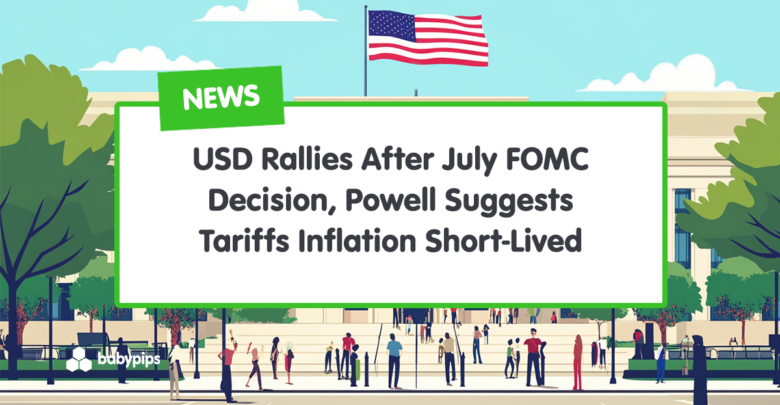The Federal Reserve maintained its benchmark interest rate in the 4.25%-4.50% range in their July policy meeting while Chairperson Jerome Powell dropped some hawkish remarks during the press conference.
Two Fed governors—Christopher Waller and Michelle Bowman—voted for an immediate 25 basis point rate cut, marking the first time two Washington-based Board governors formally dissented since December 1993. Their opposition highlighted growing internal tensions over the Fed’s approach to balancing employment and inflation concerns amid an uncertain economic outlook.
Key Takeaways from July FOMC Statement
- Rates unchanged: Fed funds target range held at 4.25%-4.50% for fourth consecutive meeting
- Economic assessment: Committee acknowledged that “growth of economic activity moderated in the first half of the year”
- Labor market view: Unemployment rate “remains low” with “solid” labor market conditions
- Inflation stance: Price pressures described as “somewhat elevated”
- Policy outlook: Fed will “carefully assess incoming data” before adjusting rates
- Historic dissent: Two governors voted for immediate 25bp cut, most governor opposition since 1993
The Fed’s decision to hold rates steady while acknowledging economic moderation reflects the central bank’s cautious approach to policy normalization. Officials appeared increasingly concerned that premature easing could reignite inflation pressures, particularly given uncertainties around tariff implementation and their potential economic effects.
The dissenting votes from Waller and Bowman reflected broader political tensions between the Fed and the Trump administration, which has repeatedly called for immediate rate cuts to support economic growth.
Link to official FOMC Statement (July 2025)
During the press conference, Fed head Powell pushed back against expectations for imminent rate cuts while emphasizing the Fed’s cautious approach to monetary easing. He characterized current policy as “modestly restrictive” and suggested the central bank was “well positioned to wait” before making policy adjustments.
The Fed chair also made what market participants interpreted as a hawkish suggestion that the central bank could be viewed as “looking through” tariff-induced inflation by not hiking rates. He suggested the Fed would likely “make a smarter decision if we wait a couple of months,” effectively casting doubt on September action.
Link to FOMC Press Conference (July 2025)
Market Reactions
U.S. Dollar vs. Major Currencies: 5-min
Overlay of USD vs. Major Currencies Chart by TradingView
The Greenback, which had already been enjoying some gains after seeing stronger than expected U.S. advanced GDP data, found additional support from the Fed decision to keep policy unchanged. What really spurred a steeper rally was the press conference, as Powell’s remarks dampened future easing expectations.
The U.S. dollar advanced against all major counterparts, with particularly strong moves against European currencies. The euro fell approximately 0.97% to the dollar while the British pound declined 0.93% and the Swiss franc slipped 0.80%.
The dollar also posted notable gains against the New Zealand dollar (+0.76%) and the typically resilient Japanese yen, which weakened 0.59% against the strengthening dollar. The Canadian dollar managed to keep its losses to a minimum at 0.20% as the currency also drew support from the Bank of Canada policy decision.

